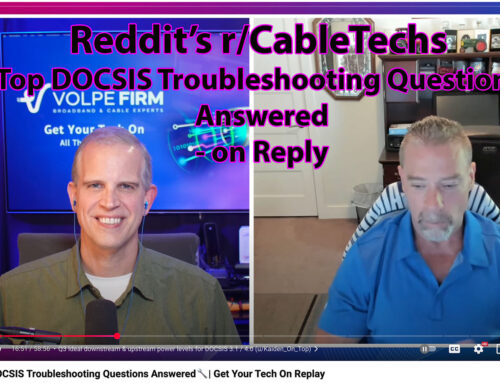Yeah Baby – Unmanaged DOCSIS WiFi – The Last 100 Maddening Feet
One Billion dollars plus is spent yearly on residential unmanaged DOCSIS WiFi accounts, according to CableLabs. You heard me right and I’m not quoting Austin Powers here. How is this possible? Okay, let’s review: Subscriber’s unmanaged WiFi networks are causing a ton of customer service representative (CSR) calls and over $1 Billion plus dollars in multiple-system operator (MSO) spending. Subscriber unmanaged WiFi is a big dollar and optics issue for the industry. Most subscribers do not understand the difference between their DOCSIS network working fine and their WIFI being slow. It’s just slow and they aren’t happy. This is where some operators CSR’s have to pull rabbits out of hats for subscribers. This article will discuss why and how we can address it as an industry.
Quality WiFi service is critical to our DOCSIS networks from a subscriber quality of experience (QoE) perspective. Our industry continues to increase service tiers to subscribers. When a subscriber orders a 100 Mbps tier and performs a speedtest over WiFi it is essential that their WiFi network is capable of supporting 100 Mbps. Unfortunately, there are a myriad of reasons that many WiFi networks cannot support anywhere close to these speeds essentially making it appear that our DOCSIS networks are performing poorly. It now becomes the responsibility of the cable operator to manage the subscriber WiFi in addition to the DOCSIS network. Enter the last 100 maddening feet.
Why is Unmanaged WiFi Problematic?
Let’s first understand what is going wrong with our unmanaged WiFi networks that is making them so slow. By definition of “unmanaged” we have no control or insight to the subscriber WiFi network. Things that impact WiFi speeds include:
-
- Location and orientation of the WiFi device
-
- Existence of other WiFi devices on the same frequency
-
- Presence of other noise sources on the same frequency
-
- Capabilities of the WiFi device – is WiFi access point really old?
-
- Interference from roaming mobile devices
- And more…
If a subscriber lives in a rural area they are much less likely to have interference problems from adjacent WiFi access points and roaming mobile devices than someone who lives in an apartment building. Suburban and urban subscribers generally suffer the most from unmanaged WiFi service because they have the most adjacent interference occurring from their neighbors. These subscribers also happen to be our largest customer base, so as an industry it is important we take care of the situation and get the 60% CSR WiFi call situation manageable for our business and our subscribers.
What are the Solutions?
There are no TaDa moments here with a magic wand but there are a number of real world solutions. It begins with taking control of or managing the WiFi access points of our subscribers – at least for those subscribers who are not proactively managing their own WiFi networks – this is the majority or our subscriber base.
Managed WiFi is generally any WiFi access point that enables the MSO to have visibility into the performance of the WiFi network and further have the ability to change the parameters of the WiFi access point to improve its performance.
How is this done? Two standards enable the management of WiFi networks. One is based off of technical report 069 (TR-069). I’ve been discussing TR-069 since 2014. TR-069 is a technical specification that defines an application layer protocol for remote management of end-user devices. It was published by the Broadband Forum and entitled customer-premises equipment (CPE) wide area network (WAN) Management Protocol (CWMP).[1] There are a handful of MSOs who do use TR-069 today to manage WiFi, but TR-069 is yet another application to manage and for that reason has not been widely adopted across the industry as a standard.
The CableLabs PNM working group is focused on managed WiFi using the simple network management protocol (SNMP) WiFi MIB. Integrating this MIB into existing back-office systems is an obvious benefit because it does not require adding new infrastructure. The majority of cable operators are using SNMP to monitor their subscriber equipment today, so extending SNMP to manage WiFi access points is trivial.
CableLabs WiFi Working Group
The CableLabs WiFi working group is tasked to develop a solution that will resolve the industry problem with WiFi. Currently they have identified six (6) key metrics they are able to monitor in WiFi access points over the DOCSIS network which they believe will resolve 75% of all WiFi network issues. This is a big deal! If we assume WiFi is a $1 Billion problem for our industry this translates into a $750M potential savings for MSOs each year and a reduction of 60% in CSR calls.
Receive signal strength indicator (RSSI) is just one of the six key metrics that CableLabs is focused on. RSSI indicates the wireless RF signal level that each remote device, such as your iPad, is being received at the WiFi access point. Using SNMP we can directly query the WiFi access point and measure the RSSI per device.
Here is a simple example of how SNMP is used to communicate with a WiFi enabled DOCSIS gateway to see the receive power of the devices associated with the WiFi access point:
$ snmpwalk –v2c –c public 10.1.4.8 .1.3.6.1.4.1.4491.2.5.1.1.9.1.6
SNMPv2–SMI::enterprises.4491.2.5.1.1.9.1.6.10001.1 = INTEGER: –75
SNMPv2–SMI::enterprises.4491.2.5.1.1.9.1.6.10001.2 = INTEGER: –37
The above shows a very simple SNMPWALK of a single cable modem with an integrated WiFi access point. In this example we have two devices connected to the WiFi access point. The first device has a receive level of -75 dBm while the second device has a receive level of -37 dBm. These are power levels just like a settop box or cable modem’s receive levels. You can convert dbm to dBmV using the following formula: 0 dBm = 48.75 dBmV.
Visually we can view the receive power of the two devices in figure 1.
Figure 1: Receive Power at DOCSIS WiFi Access Point from Two Devices (RSSI)
Figure 1 is showing the RSSI for both devices associated with the WiFi access point. The optimal RSSI varies based on a number factors, such as noise, number of associated devices, and the desired data rates. It’s important to know that dBm does not scale in a linear fashion like you’d expect, instead being logarithmic. That means that signal strength changes aren’t smooth and gradual. The Rule of 3’s and 10’s highlights the logarithmic nature of dBm:
-
- 3 dB of loss cuts the signal strength in half
-
- 3 dB of signal gain doubles the signal strength
-
- 10 dB of signal loss means 10 times less signal strength
- 10 dB more signal means 10 times more signal strength
So what RSSI is good? For simple, low-throughput tasks like sending emails or browsing the web, -70 dBm is fine. For higher-throughput applications like voice over IP or watching Netflix, -67 dBm is the bare minimum. In our SNMPWALK example above we can observe a problem. One device has excellent RSSI of -37 dBm. This device should get good performance – should is in bold, because there are other factors that could impact performance. The second device has an RSSI of -75 dBm. This is 5 dB less than our bare minimum of -70 dBm for low-throughput tasks and 8 dB (nearly 100 times) less level than what we require for higher-throughput applications such as streaming Netflix.
This is something actionable if the subscriber calls into the CSR and complains about DOCSIS network speed tests, streaming issues, or Facetime problems! If the device they are having issues with has an RSSI below -67 dBm (-75 dBm in our example) we know their WiFi network does not have enough coverage in their home. There are a number of solutions to expanding coverage, which are beyond the scope of this article. Understanding the root cause of the problem, however is often critical to the solution and subscriber satisfaction.
Wrapping Up
WIFI is a significant issue in the industry, which many are all too familiar with. For some pulling a rabbit out of a hat might be harder than addressing these issues. Fortunately there are tools, such as TR-069 and SNMP-WiFi that enable us to address these issues directly without rolling a truck to subscriber’s homes each time. In fact many WiFi issues can be remotely diagnosed and resolved without ever dispatching a truck!
In my example I showed how we can directly measure RSSI – the receive power of each device on a DOCSIS WiFi access point. This is only one of many key metrics we can monitor for the overall health of subscriber’s WiFi networks. Further, TR-069 and SNMP-WiFi allow us to make changes to subscriber WiFi networks, such as the WiFi radio channel, security, and even reset the subscriber’s WiFi password should they forget it.
The password reset, while trivial, is something that I wish I could have enabled for my neighbor’s and mother’s WiFi network on demand. The hours of emergency “Brady-on-call” service this would have saved me over the years would be awesome!






Leave a Reply